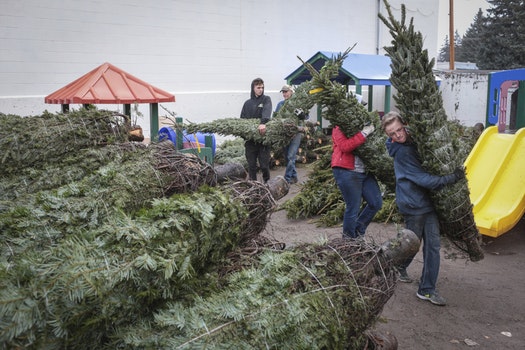All the trimmings without the tree
Consumers pine for lower prices in Christmas tree shortage

This November, volunteers unload Christmas trees at a YMCA in Idaho.
As the smell of gingerbread and hot cocoa fill the air, you notice that something is missing. After thinking long and hard about the lack of a certain scent, you come to the realization that you forgot the tree. Christmas is incomplete without the fresh fragrance of pine. So what happens when there are fewer trees available or the prices are too high?
According to the National Christmas Tree Association (NCTA), there is a shortage of Christmas trees this year (2017). Out of the nearly 15,000 Christmas tree farms across the U.S., many will take a hit. The source of the decrease has been determined to be from the Great Recession beginning in 2008. As the economy was doing poorly, fewer people were buying fresh trees. The decline of consumers led farmers to leave the trees to grow longer because there would be no point to cut them down.
Now that there are trees taller or shorter than the average height that consumers tend to purchase— anywhere from seven to eight feet— growers and consumers alike are feeling the effects.
Not only is the low supply of trees causing issues, diesel fuel prices are as well. The American Automobile Association recorded that diesel fuel is 46 cents more to a gallon than this time in 2016. That means that truckloads of trees are being charged with higher shipping costs.
As a result, prices may be driven up an additional five to 10 percent. The larger the tree, the higher the extra charges will be.
These raised prices can potentially lead to even higher prices in the future. This is because the more people who switch to fake firs, the more they will cut into the estimated 25 to 30 million sold annually. This will mean more growers will have to sell the trees at greater prices, according to Newsweek. This may even extend into seasons to come, as the trees only grow approximately a foot per year.
The shortage is really hurting the top-ranking states for Christmas tree production: Ore., N.C., Mich., P.A., Wis. and Wash.
In 2016, 27.4 million people bought farm-grown trees, compared to only 18.6 million purchasing artificial trees. However, since 2010, the gap between the two has been closing slowly. Each year, fewer and fewer people are buying authentic trees.
The average price consumers reported spending on a tree last year was $74.70, according to the NCTA,
In order to beat the high prices, some people bought their trees as early as Thanksgiving. And while most of the optimal selection may be picked over, some growers reduce prices at the end of the season in order to clear their stock. Other solutions to save money are cutting the tree yourself instead of buying it pre-cut or purchasing an artificial tree.
To find your perfect tree, you can look on the tree locator on the NCTA’s website at www.realchristmastrees.org.


